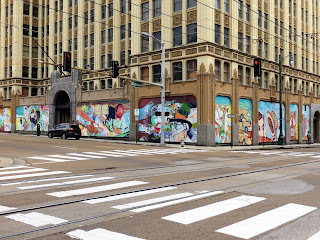I took photos of EZ Daze RV Park as well. It looked so fresh after the rain.
 |
| Our site at EZ Daze RV Park. It's pretty outside now that the rain has ended! |
 |
| The sign on the building can easily be seen from the road. |
 |
| EZ Daze RV Park office. |
 |
| A beautiful tulip tree in bloom. |
 |
| What the park looks like. |
Friday, April 5: The Cotton Museum is a few blocks away from the big Tennessee Visitor Center by Mud Island. There is free parking at the Visitor Center. We asked at the desk if we could park there while we walked around downtown and they said yes. Little did we know we'd be there from morning until dusk! The truck was still there when we got back. Whew!
Our day started in the Cotton Museum. This building was the Memphis Cotton Exchange, and in years past many others started their days in this building when cotton was king.
The Memphis Cotton Exchange was first organized in 1873 and is still operating today, though cotton trading is now done by computers. In the early 1950s, a seat on the Exchange could cost a new member $17,000. Memphis was the largest spot cotton market in the world from 1880 to 1930.
 |
| Memphis Cotton Exchange trading floor. |
"Memphis was established in 1816 as a shipping port for cotton and was a major hub in the slave trade. Downtown streets once bustled with cotton-related commerce in a neighborhood called Cotton Row. The influence of the industry and the traditions of the people who were gathered around it are forever woven into the cultural fabric of our city."But that description does not apply to all people. The slaves had no rights and were treated worse than animals. As we learned yesterday in the Civil Rights Museum, slaves were a big business and they were NOT independent, they were "property" and could be bought and sold, according to their owners and the slave trade.
 |
| A wall of cotton businesses. |
 |
| A cotton gin. |
 |
| Items made from cotton, cottonseed oil, or other cotton by-products. |
Over the years, cotton production has been mechanized. I know I was surprised the first time I saw a huge cotton "module" in a field. The three photos below show the process.
Remember, the slaves who were brought to America were once independent people in their home countries. What would your state of mind be if you had to endure a months'-long journey on a slave ship, not knowing if you would survive? Then, when you arrived in the "New World," you were sold to a master. You do not know the language, you have no money, if you disobey, you are whipped mercilessly. You would be a rebellion waiting to happen.
In the meantime, the slaves developed their own plaintive songs. These melancholy songs became the blues and soul music, which later morphed into rock 'n' roll and country music.
The interconnectedness of all this history is amazing. Through repression and hatred against them, the slaves toiled. Their lot in life was controlled from birth in the United States. I can only imagine their frustration. The blues and soul music helped them share their emotions.
While the Cotton Museum was interesting with stories about the cotton gin ("gin" being short for engine), genetic engineering, the Memphis Cotton Carnival for white High Society (no blacks allowed), and black Cottonmakers Jubilee, it tended to sugar coat the slave situation.
After touring the Cotton Museum, we borrowed the "Walking Tour" headphones from the museum. Mine worked for the first couple of stops, and Bob's were jumping from one stop to another stop four or five numbers ahead. Then mine fizzled out and weren't going in order either. We got frustrated and turned the headsets back in. We explained to the receptionist that the walking tour wasn't working properly.
From there, we went to lunch at Front St. Deli. It was pretty good. All their sandwiches were named after actors.
 |
| Front St. Deli. |
 |
| Bob gave me the eye for taking "another" photo of him. |
 |
| Peabody ducks crosswalk. Ha! |
 |
| Fourth Bluff walkway along the Mississippi. |
 |
| The riverboat by Mud Island. |
 |
| "Tiger Justice" sculpture by Rebecca Zerilla Cannon. "All people are created equal under the law." |
 |
| I love this! In front of Cecil C. Humphreys School of Law. |
 |
| Memphis Trolley. |
 |
| Bottom of the building has lots of murals. |
 |
| Here are the murals. |
 |
| AutoZone Park. |
 |
| The Memphis Redbirds play in AutoZone Park. |
 |
| Art along Memphis Blues Trail. |
 |
| Me on the Memphis Blues Trail. |
 |
| Interesting signs and art. |
 |
| Great quote! |
Even after slaves were "freed," they were not equal to the whites. Jim Crow laws were enacted in the south. Blacks couldn't live like whites. They were segregated, pushed aside, passed over. It was time for an uprising. Martin Luther King, Jr., had a message that resonated with the people. The time was ripe for change.
At the Memphis Rock 'n' Soul Museum (Smithsonian Institution Affiliations Program) we listened to the musical artists put their heart and soul into their music. Music that would be heard nationwide and worldwide. Gospel was the bedrock of early soul music. Gospel combined with hillbilly music went on to become soul, blues, jazz, country, and rock 'n' roll music. This music would let others know they had kindred spirits.
W. C. Handy is known as the Father of the Blues. He wrote and published blues songs. Handy's written compositions standardized blues music that previously had only been learned in passing or by memorization.
 |
| B. B. King |
 |
| Me "recording" in Sun Studio. Yeah, right. |
 |
| B. B. King's guitars |
 |
| Bob by one of Elvis's outfits. He wore a similar one when he sang, "Ain't Nothin' but A Hound Dog" one time. |
 |
| Tony Gentry's guitars - autographed by many musicians he met or performed with. |
 |
| Customized Triumph motorcycle owned by Sam the Sham (of the Pharoahs). |
 |
| A whole room dedicated to Elvis's movies. |
 |
| Bob in front of the FedEx Forum. |
To get to Mud Island, you walk across a pedestrian bridge or take a monorail. The monorail was not running so we walked over.
 |
| Walkway to Mud Island. |
 |
| Walkway to Mud Island - Visitor Center parking below. |
 |
| Great rocking chairs for a rest. |
 |
| My feet say, "Thank you." |
 |
| This explains the Mississippi Riverwalk. |
 |
| Usually, this has water in it, so we had to imagine that. It's a relief map of the Mississippi River (1/2 mile long). |
 |
| Bob pointing out interesting features. |
 |
| Downtown Memphis skyline at sunset. |
 |
| Another beautiful sunset over the Mississippi River. |
Let's call it a day, shall we?











No comments:
Post a Comment
Please let me know what you think, your experiences, and constructive criticism to make this blog stronger.